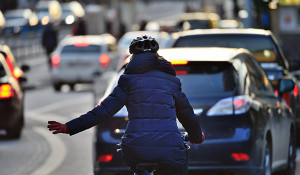26th January, 2022
In a bid to make the roads safer, a new set of risk-based driving regulations will soon be introduced.
The new regulations will apply to all road users in the UK, as they touch on the likes of roundabouts, junctions and crossings – all of which we encounter in our day to day.
Here at One Call Insurance, we’re encouraged by these changes and look forward to welcoming a much safer environment for pedestrians and motorists alike.
Whether you drive a car, van or motorbike our aim is to help you remain safe. With that in mind, we’ve outlined some of the major changes to help you avoid inadvertently breaking the law.
We encourage you to read our summary, as failure to follow the new rules could see you risk a £200 fixed penalty notice and six points on your licence.
Essentially, the changes to the Highway Code will put more responsibility on drivers, whilst giving higher priority to vulnerable road users like pedestrians and cyclists.
The new rules will come into effect on 29th January and set out a new hierarchy of road users.
Sitting at the top of the hierarchy are ‘riskier’ road users, such as heavy goods vehicles, coaches, buses, vans and cars. Drivers of such vehicles will be given a greater responsibility to minimise risk posed to those sitting at the bottom of the hierarchy – from pedestrians and cyclists to horse riders.
Rule H1 states: “Those in charge of vehicles that can cause the greatest harm in the event of a collision bear the greatest responsibility to take care and reduce the danger they pose to others.’‘
“This principle applies most strongly to drivers of large goods and passenger vehicles, vans/minibuses, cars/taxis and motorcycles.”
The rule also specifies that whilst cyclists and horse riders have a responsibility to look after pedestrians, all road users are responsible for ensuring their own safety, and that of others.
Rule H2 is for all drivers, motorbike riders, horse riders and cyclists, and states: “At a junction you should give way to pedestrians crossing or waiting to cross a road into which or from which you are turning.”
Drivers must give way to pedestrians waiting at a zebra crossing and to any pedestrians and cyclists waiting to cross at a parallel crossing.
Cyclists will have to give way to pedestrians on shared-use cycle tracks. Only pedestrians (including wheelchair and mobility scooter users) may use the pavement.
Rule H3 is for all drivers and motorcyclists and states: “You should not cut across cyclists, horse riders or horse drawn vehicles going ahead when you are turning into or out of a junction or changing direction or lane.”
This rule applies to roads, cycle lanes and cycle tracks.
Drivers must wait for a safe gap before turning at junctions, going around a roundabout and when moving past or waiting alongside stationary or slow-moving traffic.
This rule also says cyclists will now be able to ride in the centre of a lane so they become more visible.
Under Rule 62, cyclists are advised to slow down when overtaking pedestrians and horses and alert them by using their bell.
Road users should not pass pedestrians, horse riders or horse drawn vehicles closely or at high speed, particularly from behind. Be prepared to slow down and stop.
Rule 72 states cyclists should ride in the centre of the lane to make themselves as visible as possible on quiet roads and slower moving traffic, but they should move to the left to allow faster vehicles to overtake, if it is safe to do so.
When riding on busy roads cyclists should allow faster traffic to overtake them, if they can do so while keeping a minimum distance of 0.5 metres.
According to rule 73, cyclists should use special cycle facilities where available. Where such facilities are not available, if you’re a cyclist, you should continue in the same way would if you were driving a motor vehicle.
Rule 75 explains the new ‘two stage turn’ for cyclists at junctions.
Stage 1: When the traffic lights turn green, cyclists wishing to turn should go straight ahead to the cycle symbol and turn arrow on the carriageway and wait there.
Stage 2: When the traffic lights on the far side of the junction turn green, cyclists should then complete the manoeuvre.
Rule 76 states that cyclists going straight ahead at a junction have priority over traffic waiting to turn into (or out of) the side road - unless signs or marking indicate otherwise.
Another update to Highway Code specifies drivers should use the “Dutch Reach” to open their car door before they get out.
This involves using the hand furthest from the door. As you reach for the handle, you should turn your body towards the door and look over your shoulder as you exit the vehicle.
You may wonder why such a set of rules has been introduced - but, statistics from the Department for Transport (DfT) are able to justify. Research shows that 4,290 pedestrians and 4,700 cyclists were killed or seriously injured in crashes on Britain’s roads in the year to the end of June 2021.
We understand that this is a lot of information to take in. But, there is more.
A full summary of the changes is available on the Gov.uk website, and the full Highway Code is available to read online too.
As a road user, it is your responsibility to make sure you have researched and understood the new rules and guidance set out in the Highway Code - ahead of its introduction on 29th January.
* By clicking this link, you will be redirected to away from our website.
* Please note that the above information has been gathered through secondary research. The information provided is not based on our opinion. You should seek further guidance and information before making an informed decision.

